

|
|
The Film
 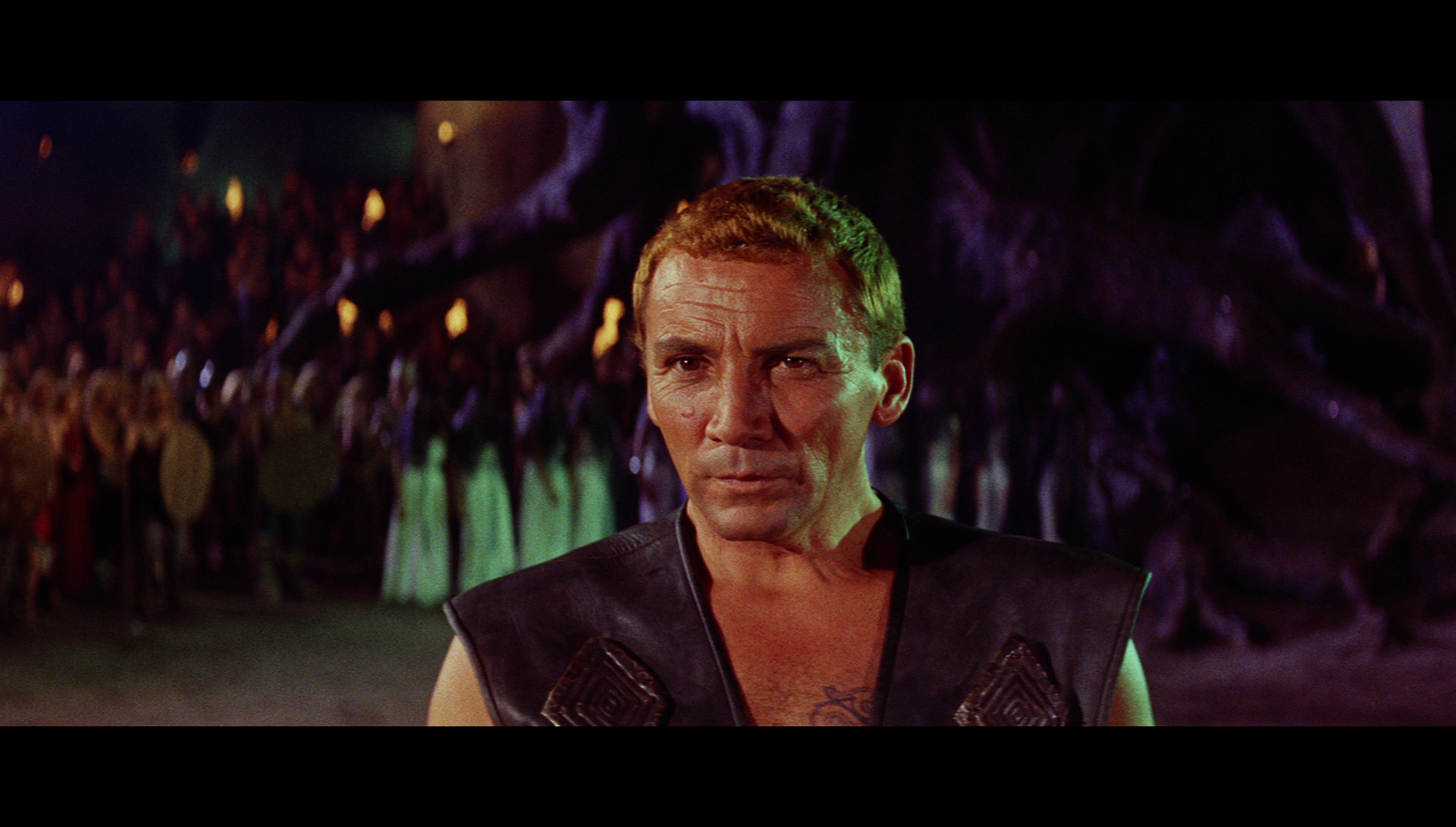 Gli invasori (Erik the Conqueror, Mario Bava, 1961) Gli invasori (Erik the Conqueror, Mario Bava, 1961)
In 786AD, the village of Viking warlord Harald (Folco Lulli) is ransacked by British invaders led by Sir Rutford (Andrea Checchi). This is part of an ongoing series of conflicts between the British and the Vikings. Rutford has been ordered to negotiate with Harald, but defying King Lotar (Franco Ressel), Rutford has Harald executed in front of Harald’s young sons Eron and Erik. Erik and Eron are taken from the scene by their father’s associate Ragnor, but when Ragnor is also killed, the brothers are separated. Eron is taken by the fleeing Vikings, but Erik is left behind. Rutford is chastised for his role in the massacre by King Lotar. One of Rutford’s men shoots an arrow through the throat of King Lotar, killing the monarch before laying responsibility for his death on an already-deceased Viking. Mourning the death of her husband, Queen Alice wanders across the beach and discovers the near-drowned Erik. Taking pity on the boy, and presumably unaware of his heritage as Harald’s son, Queen Alice takes Erik as her own child. Twenty years pass, and Erik (George Ardisson) has been raised as the son of Alice and heir to the throne. He has assumed the title of Duke of Helford and commander of the British navy. Meanwhile, his brother Eron (Cameron Mitchell) is in love with Daya (Ellen Kessler), who along with her twin Rama (Alice Kessler) is a priestess betrothed to the Norse god Odin. Eron’s affair with Daya is forbidden and can only be consecrated if Eron assumes the mantle of leader of the Vikings.  When Harald’s successor Olaf (Jean-Jacques Delbo) declares war on the Britons but asserts that he is too advanced in years to successfully lead the Viking armies on such a perilous mission, Eron seizes his chance – but only after a duel to the death with his chief rival Garian (Joe Robinson). Eron wins the duel but refuses to slay Garian, instead taking the fierce warrior as his right-hand man in the battle against the British. When Harald’s successor Olaf (Jean-Jacques Delbo) declares war on the Britons but asserts that he is too advanced in years to successfully lead the Viking armies on such a perilous mission, Eron seizes his chance – but only after a duel to the death with his chief rival Garian (Joe Robinson). Eron wins the duel but refuses to slay Garian, instead taking the fierce warrior as his right-hand man in the battle against the British.
A sea war rages, during which Erik’s ship is sunk. Eron reaches the shores of Britain and takes Queen Alice captive. Eron plans to return to the ‘Land of the Vikings’, and appoints Rutford ‘Regent, to rule in my absence’. Meanwhile, Erik is discovered on the beach of the ‘Land of the Vikings’ by Rama, and the couple quickly fall in love with one another. When Rama sees Queen Alice, with whom Eron has returned, and notes that about her neck is the same crucifix worn by Erik, Rama realises that Erik must be Queen Alice’s adopted son. She returns to Erik and the pair plot to rescue Alice. However, before they can achieve their goal Erik is recognises as the Duke of Helford by Eron (though Eron does not realise that Erik is in fact his long-lost brother). Eron takes Erik captive, but Erik is freed by Rama, who hides Erik in a network of caves. Erik and Rama follow through with their plan to rescue Queen Alice, taking her back to Britain. However, the Viking armies are in pursuit, leading to a final conflict between the long-separated brothers Erik and Eron. Also released in English as Fury of the Vikings, Mario Bava’s Gli invasori (1961, and released here under the title that accompanied its American release, Erik the Conqueror) was one of two Viking-themed pictures that Bava made with American star Cameron Mitchell, the second being I coltelli del vendicatore (Knives of the Avenger) in 1965. 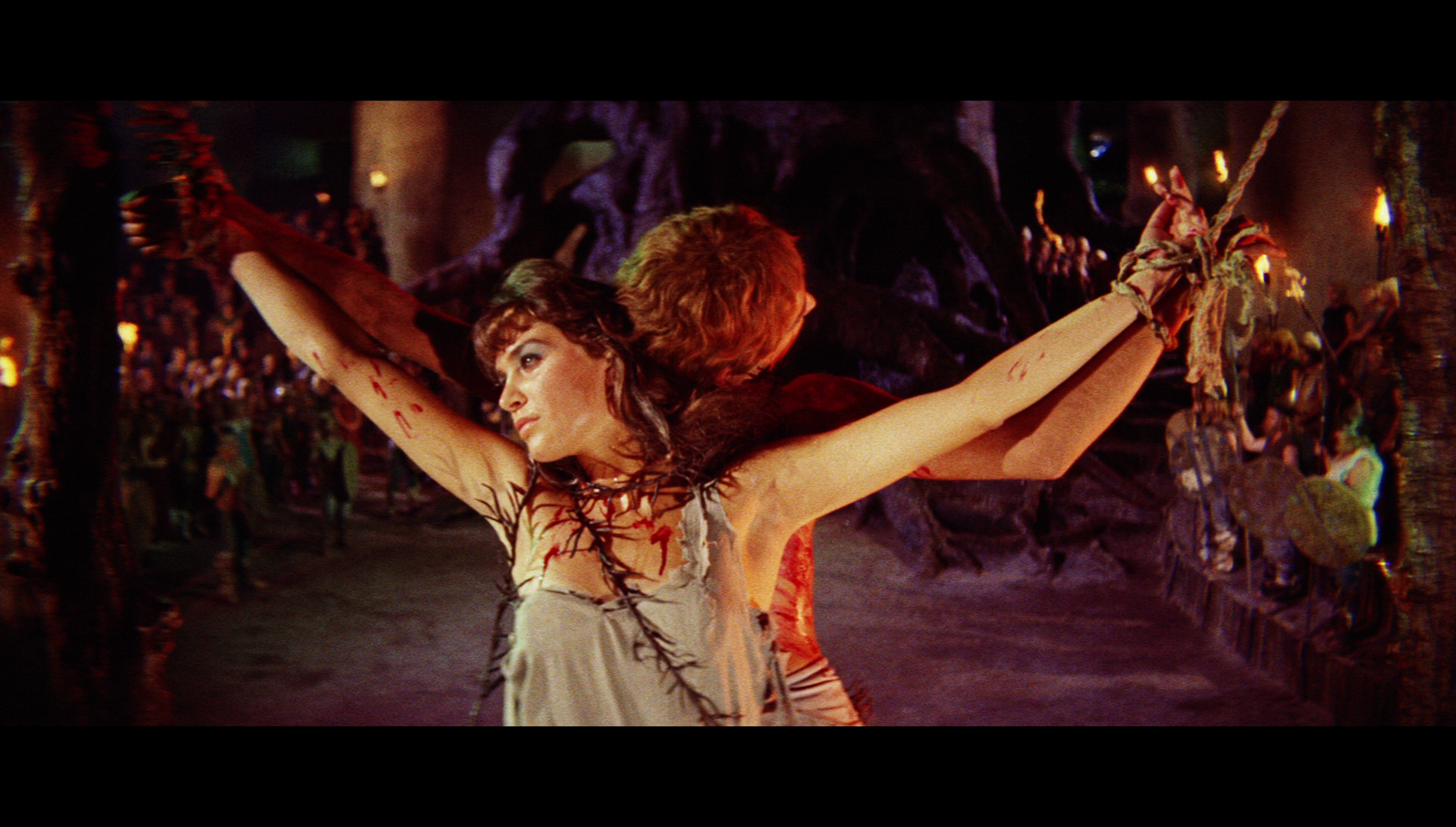 The narrative of Gli invasori owes a noticeable debt to Richard Fleischer’s then-recent Hollywood picture The Vikings (1958), adapted from Edison Marshall’s novel The Viking, in which Kirk Douglas and Tony Curtis play half-brothers, descendants of the Viking rule Ragnar (Ernest Borgnine), who become mortal enemies. Edison Marshall’s source novel had been rooted in the sagas of Ragnar Lodbrok whose sons, according to Norse legends, sought revenge against Northumbrian King Ælla for the execution of Ragnar. Likewise, Gli invasori has some superficial similarities with the stories of Ragnar and his sons. The narrative of Gli invasori owes a noticeable debt to Richard Fleischer’s then-recent Hollywood picture The Vikings (1958), adapted from Edison Marshall’s novel The Viking, in which Kirk Douglas and Tony Curtis play half-brothers, descendants of the Viking rule Ragnar (Ernest Borgnine), who become mortal enemies. Edison Marshall’s source novel had been rooted in the sagas of Ragnar Lodbrok whose sons, according to Norse legends, sought revenge against Northumbrian King Ælla for the execution of Ragnar. Likewise, Gli invasori has some superficial similarities with the stories of Ragnar and his sons.
Gli invasori was made hot on the heels of another Italian Viking-themed film starring Cameron Mitchell, Giacomo Gentilomo’s L'ultimo dei Vikinghi (The Last of the Vikings, 1961). Though, like L’ultimo dei Vikinghi, Gli invasori’s production was no doubt inspired by the popularity of The Vikings, Bava’s film’s staging fits strongly into the paradigms of the pepla/sword-and-sandal films that had been popular in Italy since Pietro Francisci’s 1957 picture Le fatiche di Ercole (Hercules). Bava’s previous film, his second credited picture as director, had been the peplum Ercole al centro della Terra (Hercules in the Haunted World, 1961), and Erik the Conqueror reuses some of that film’s sets. Additionally, as in Ercole al centro della Terra, in Gli invasori Bava makes strong use of primary colours, cast over the sets and actors via the use of coloured gels on directional lights. Bava’s use of colour in these two films would work its way into the Gothic horror films for which the director is more famous – at least, to international audiences – beginning with I tre volti della paura (Black Sabbath, 1963) and La frustra e il corpo (The Whip and the Flesh, 1963). Gli invasori opens with Sir Rutford and his men attacking a Viking village and slaying Harald in front of his young sons Erik and Eron. Though a fairly common trope in pepla, the staging of this sequence, and the intercutting of Harald with his sons as he defies Rutford before Rutford has him executed, is highly reminiscent of the opening sequence of John Milius’ later Conan the Barbarian (1982), in which young Conan witnesses the killing of his parents when his village is raided by the men of Thulsa Doom (James Earl Jones) – to the extent that one may wonder whether Milius had Gli invasori in mind whilst shooting Conan the Barbarian. 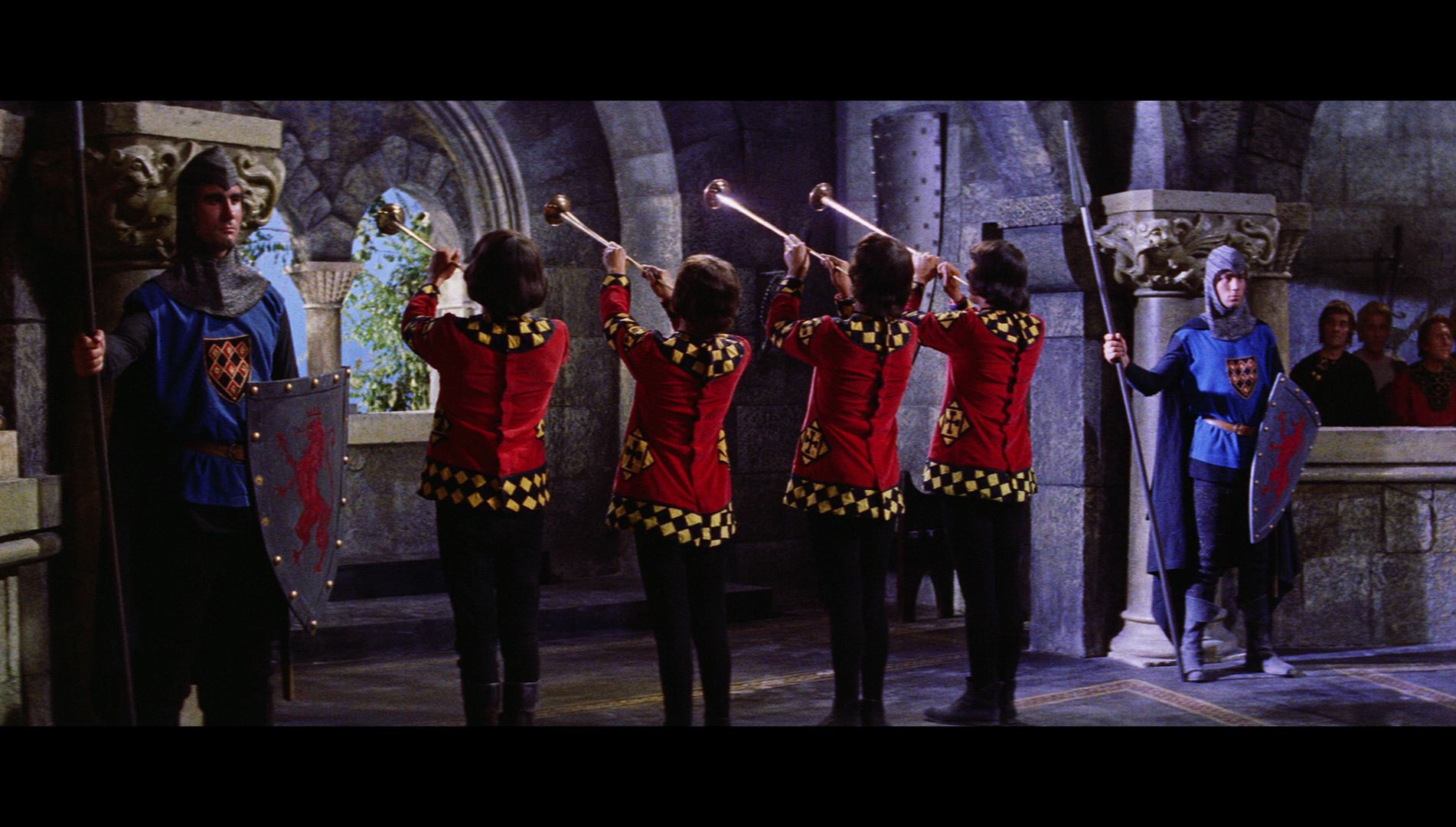 The slaying of Harald is preceded by Harald’s prophetic exclamation, ‘One day my sons will avenge me!’ From this point, the film emphasises a theme of fate or predestination, with Erik and Eron at times reflecting on their pre-written ‘destiny’ to avenge the death of their father. Even Queen Alice seems to have a similar belief in predestination: when she discovers the ailing Erik in the tide after the death of his father, she assumes responsibility for the boy, asserting that ‘[God] sent this child to me because I lost my king. He’s the son I hoped for’. Later, after Erik’s ship has been defeated by Eron’s crew during the sea battle, Erik is again discovered on a beach – but this time by the beautiful Rama. Erik is once again ‘adopted’ by a woman – though this time, of course, Rama takes Erik as her lover rather than her son. ‘All our moves are predestined’, Erik tells Rama, ‘Spared from death in battle, I was guided by fate to this strange land – so that I could find love and set my mother free’. The slaying of Harald is preceded by Harald’s prophetic exclamation, ‘One day my sons will avenge me!’ From this point, the film emphasises a theme of fate or predestination, with Erik and Eron at times reflecting on their pre-written ‘destiny’ to avenge the death of their father. Even Queen Alice seems to have a similar belief in predestination: when she discovers the ailing Erik in the tide after the death of his father, she assumes responsibility for the boy, asserting that ‘[God] sent this child to me because I lost my king. He’s the son I hoped for’. Later, after Erik’s ship has been defeated by Eron’s crew during the sea battle, Erik is again discovered on a beach – but this time by the beautiful Rama. Erik is once again ‘adopted’ by a woman – though this time, of course, Rama takes Erik as her lover rather than her son. ‘All our moves are predestined’, Erik tells Rama, ‘Spared from death in battle, I was guided by fate to this strange land – so that I could find love and set my mother free’.
Rutford is the true villain of the piece, betraying King Lotar and, latterly, Queen Alice. He refuses to commit to either the Vikings or the British, and seems motivated solely by greed, though responding to King Lotar’s shock at Rutford’s unnecessary execution of Harald, Rutford seems pathological about ‘cleansing’ Britain of the Vikings. ‘We don’t approve of your cruel methods’, Lotar tells Rutford in reference to the slaughter that has taken place in the Viking settlement, ‘You are guilty of a great massacre. That is not worthy of a British knight’. ‘It is necessary in a war with barbarians’, Rutford asserts in response: ‘No pact with those barbarians, only war’. Later, the sleazy Rutford attempts to press Queen Alice into marrying him, before betraying her to Eron’s Vikings when she responds in the negative. The film juxtaposes the ‘barbarous’ rituals of the Vikings with the ‘civilised’ rituals of the British. The ‘Land of the Vikings’ (as it is described in the film) is a seemingly subterranean place, the Vikings performing their rituals in cavernous spaces bathed in vivid purple and red light. (As the film utilises many of the same sets, it’s unsurprising that the ‘Land of the Vikings’ so strongly resembles the depiction of Hades that is featured in Bava’s Ercole al centro della Terra, released in the same year.) The first glimpse we have of this environment sees a man and young woman tied together with a rope of thorns, standing atop a wagon bedecked with skulls. They are to be executed: the young woman has made a vow to the Norse god Odin, and her relationship with the young man is a transgression of this vow; both lovers are to be sacrificed to the gods in a gesture of appeasement. Likewise, Daya and her sister have made a similar vow to Odin, and Daya’s relationship with Eron puts both of them in danger of a similar fate. (‘Only a king, by making you his wife, could release you from your vows’, Eron tells Daya, ‘And I will be king!’) 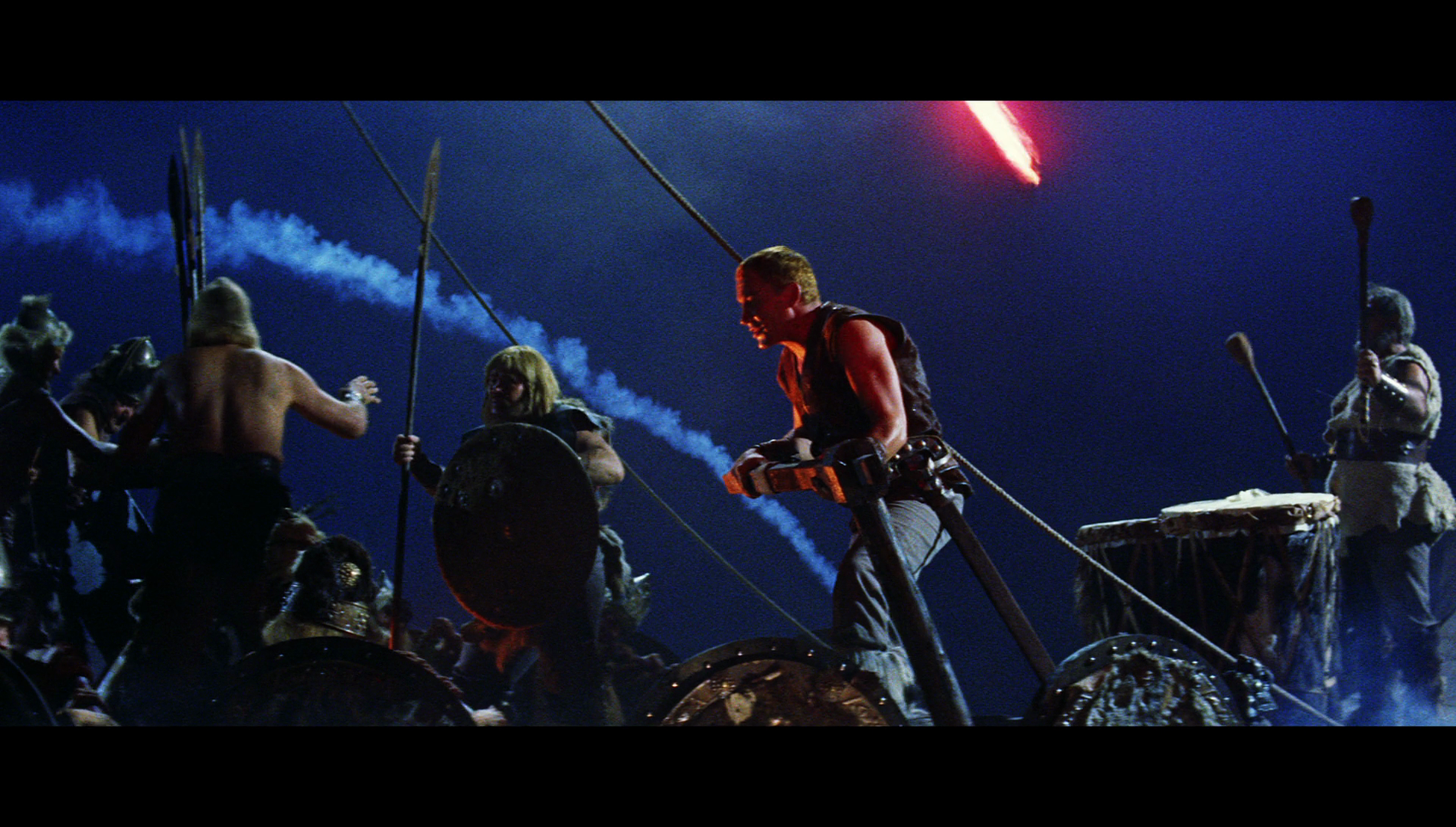 When Olaf declares war on the British, he observes that he is too old to lead the Viking armies and seeks a successor. Eron and Garian are the natural choices, Eron reminding the others of his status as the son of Harald. The film spends time establishing the rituals via which the leader of the Vikings is chosen. The tribal chiefs vote for Olaf’s successor by throwing axes at two totems – one representing Garian, and the other representing Eron. When the axes are counted, it is discovered that an equal number of tribal chiefs have voted for each candidate, and Garian and Eron are forced to duel to the death – but only after forging their own weapons (an axe and a sword, respectively) in front of the other tribal chiefs. Eron wins the duel but refuses to slay Garian (‘This brave man will fight alongside us’, Eron says), and Eron becomes the king of the Vikings. When Olaf declares war on the British, he observes that he is too old to lead the Viking armies and seeks a successor. Eron and Garian are the natural choices, Eron reminding the others of his status as the son of Harald. The film spends time establishing the rituals via which the leader of the Vikings is chosen. The tribal chiefs vote for Olaf’s successor by throwing axes at two totems – one representing Garian, and the other representing Eron. When the axes are counted, it is discovered that an equal number of tribal chiefs have voted for each candidate, and Garian and Eron are forced to duel to the death – but only after forging their own weapons (an axe and a sword, respectively) in front of the other tribal chiefs. Eron wins the duel but refuses to slay Garian (‘This brave man will fight alongside us’, Eron says), and Eron becomes the king of the Vikings.
The film cuts immediately to Britain, which is depicted very differently. The setting is established by an exterior shot of a castle in daylight before the film cuts to the interior of the castle, where a choir sings and Erik awaits the receipt of his title of Duke of Helford. Stripped to the waist, Erik is then wrapped in a luxurious fur-collared cloak which signifies his status as both Duke of Helford and the commander of the British navy. In the juxtaposition of the rituals of the Vikings with those of the British, the film establishes a tension between a world of barbarity and strange, exotic rituals that take place in a subterranean space, and a world of luxury, regality and civility (though itself associated with specific rituals). It is between these two spaces that Rutford, the film’s villain, moves. 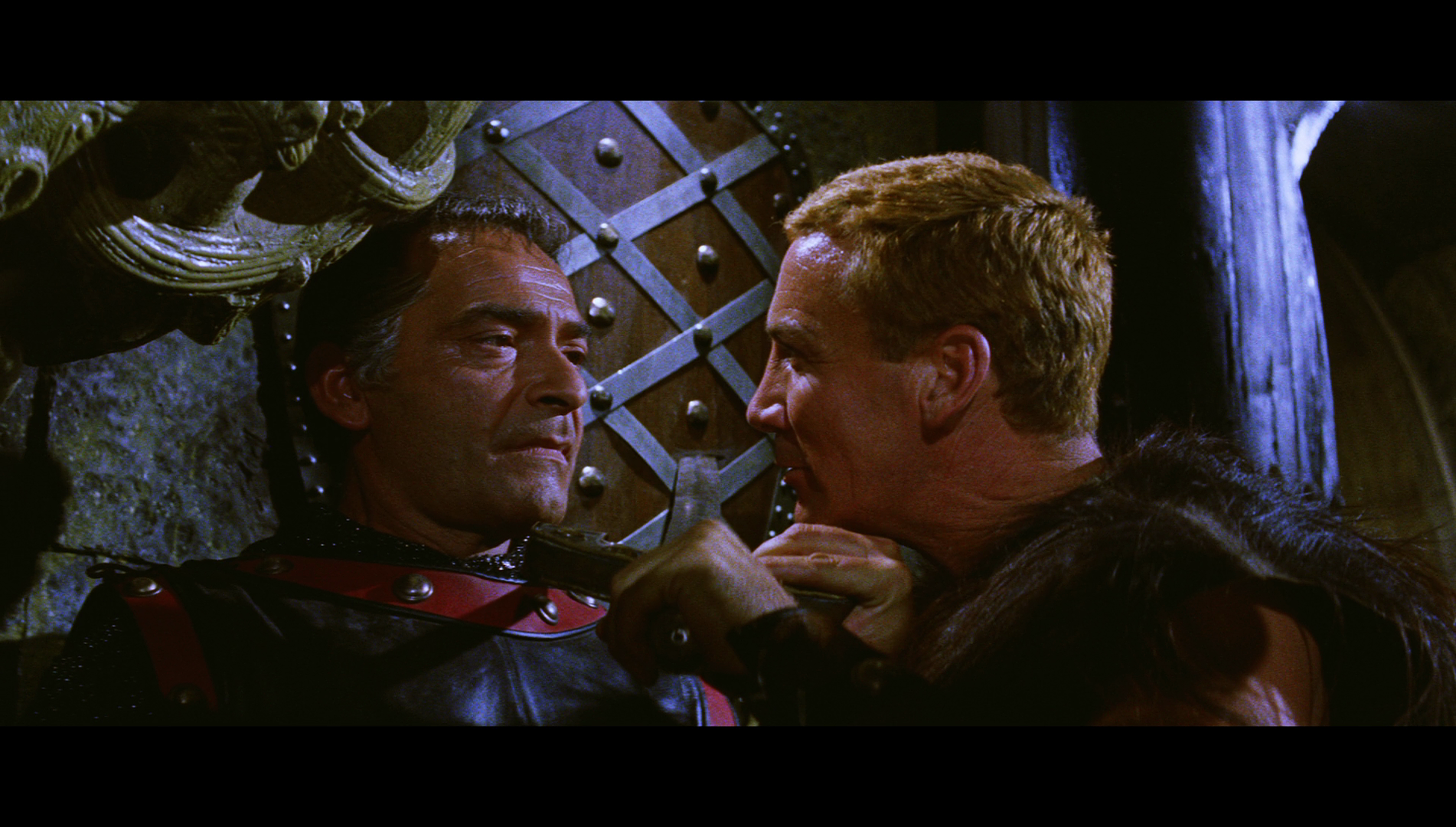 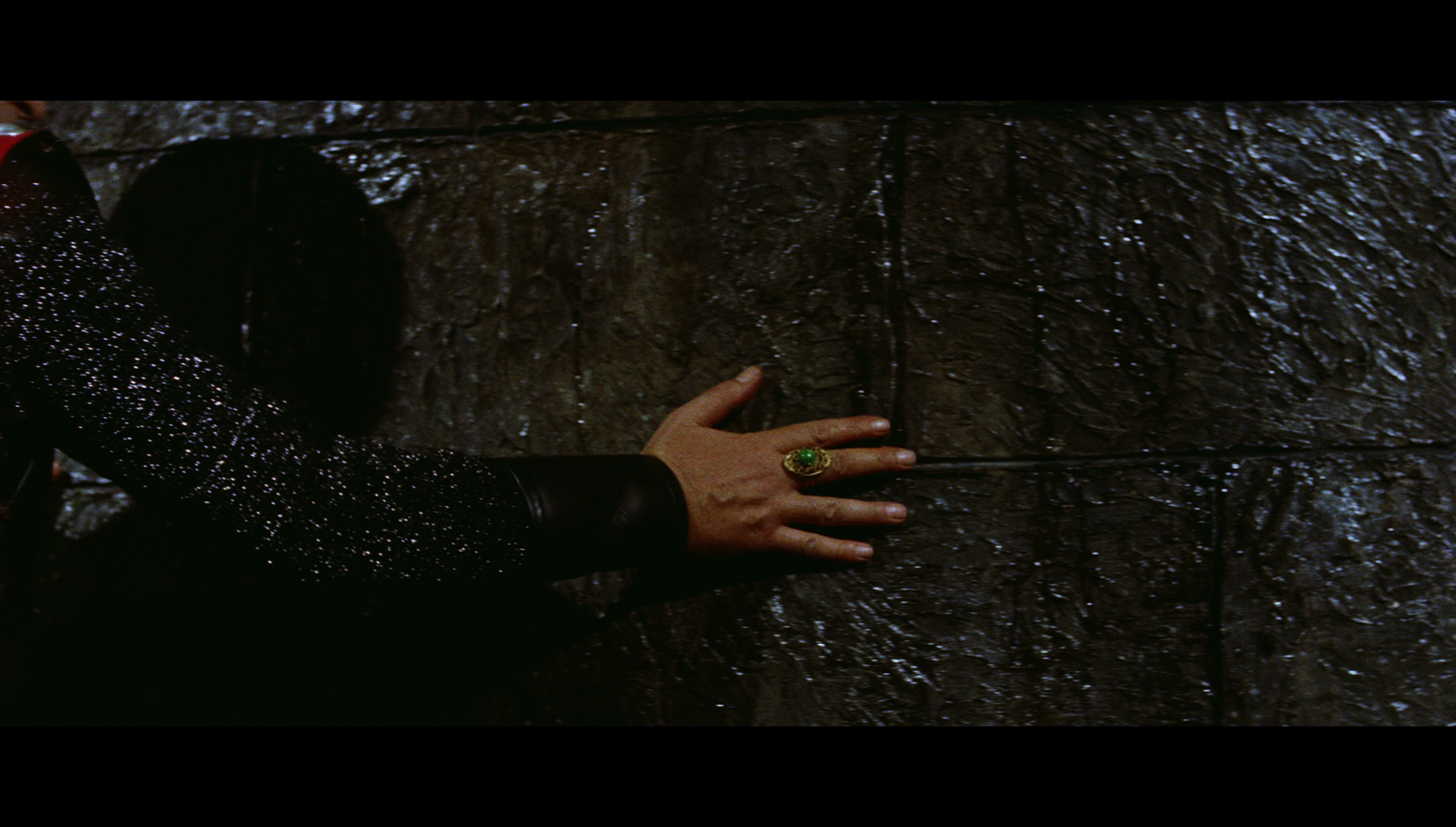 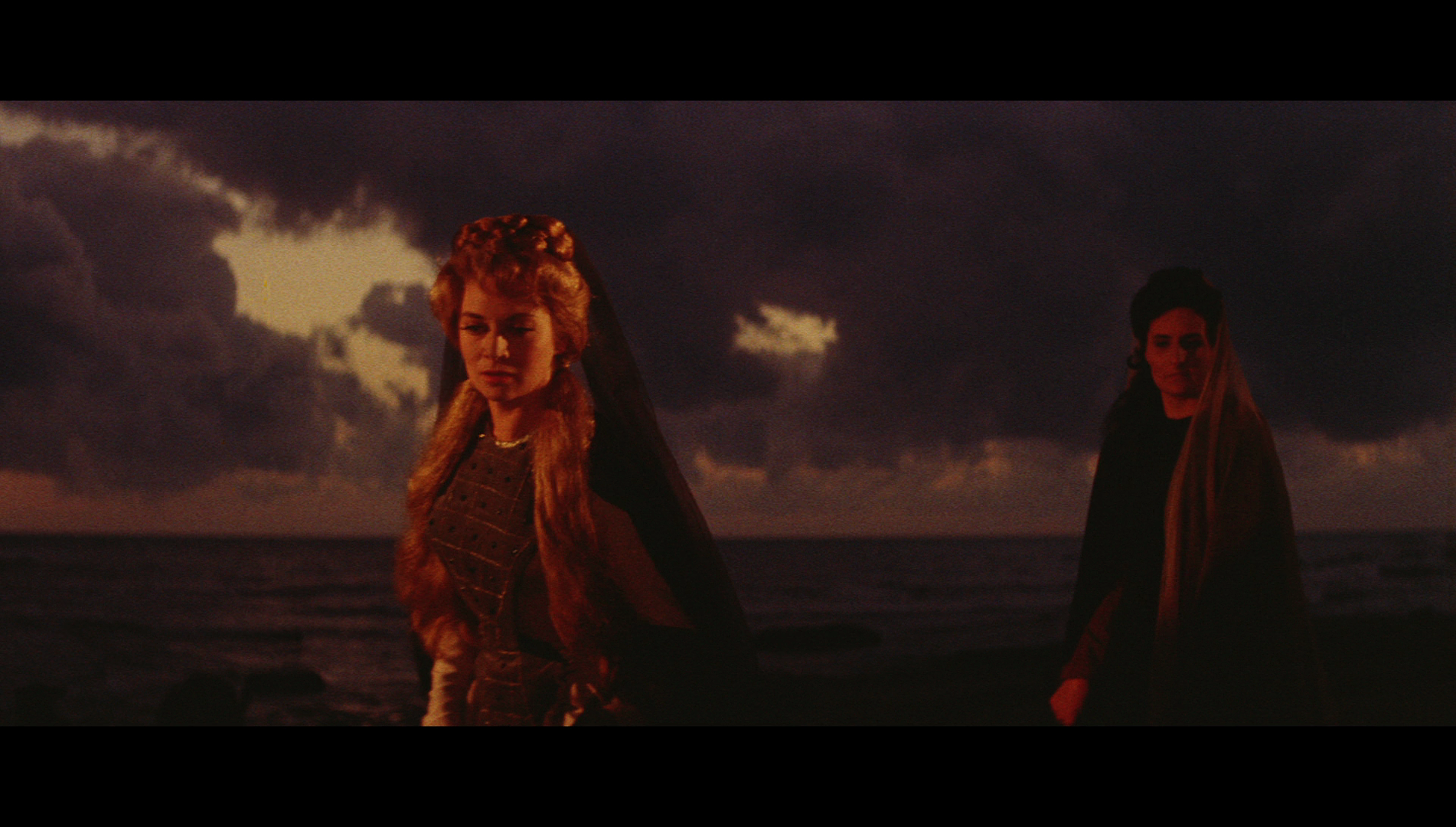
Video
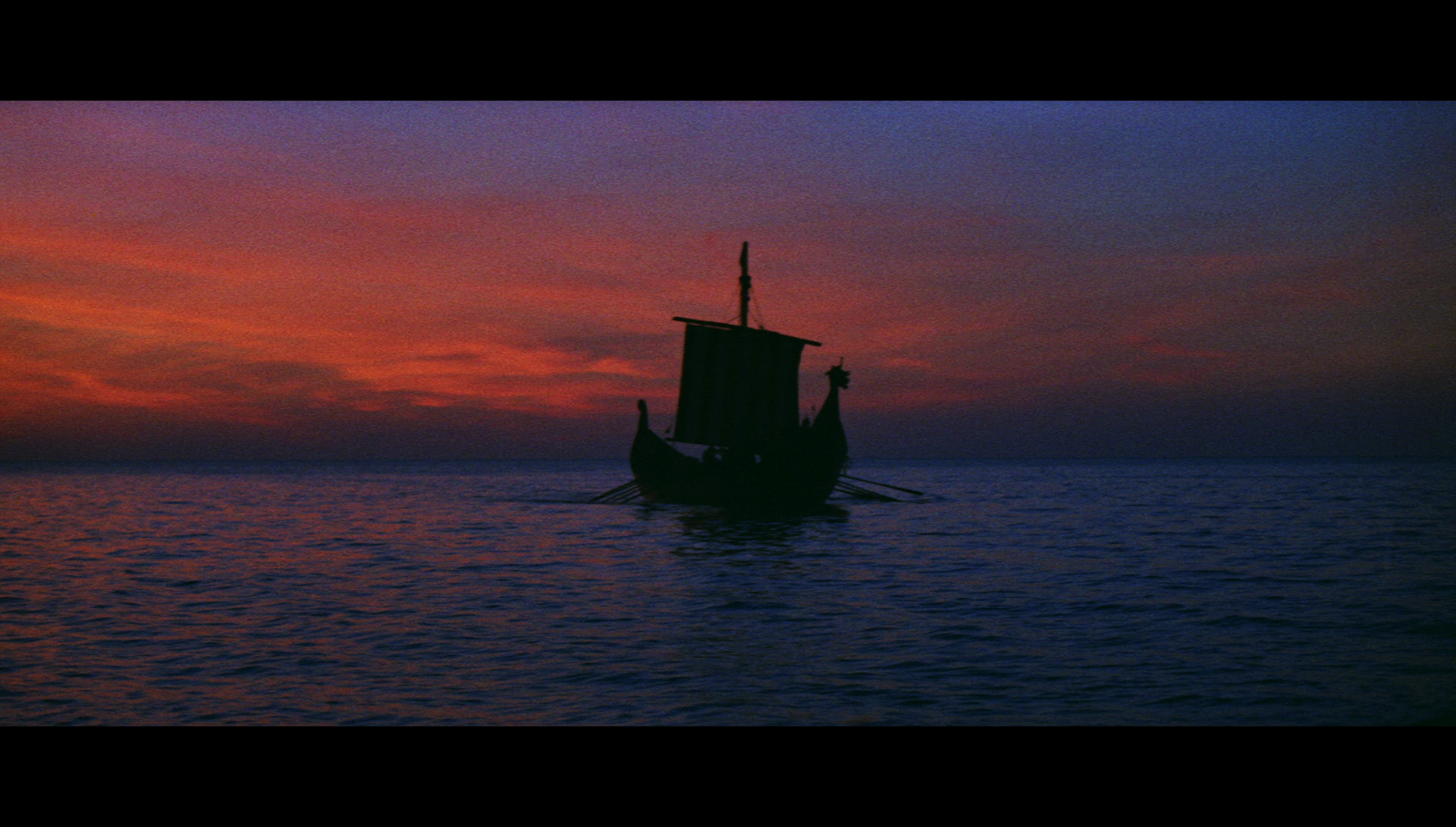 Gli invasori is presented here uncut, with a running time of 90:09 mins. The film takes up just over 27Gb of space on a dual-layered Blu-ray disc, and the 1080p presentation uses the AVC codec. Gli invasori is presented here uncut, with a running time of 90:09 mins. The film takes up just over 27Gb of space on a dual-layered Blu-ray disc, and the 1080p presentation uses the AVC codec.
The presentation is based on a new 2k scan of the film’s original negative. The film was shot in Dyaliscope, an anamorphic process, and Bava makes superb use of the widescreen frame – filling it with men during the battle scenes, giving the film a bigger sense of scale than its budget might suggest. The photography is lush and expansive, the scale of the sets emphasised by the use of shorter focal lengths; these wide-angle lenses come with noticeable barrel distortion, which is to be expected, but they also exhibit some of the more problematic characteristics of vintage wide-angle lenses. Much of the film is shot in fairly low-light studio environments, with the lenses presumably wide-open to achieve the strong depth of field evident in many scenes. This, however, has the effect of emphasising the tendency of some of these vintage wide-angle lenses, when used wide-open, to be very sharp at the centre of the frame but to feature a smeary/blurry softness towards the periphery of the image. It must be stressed that this is an issue with the lenses used during production rather than a ‘fault’ of this presentation. See the screen grab below for an example of this. 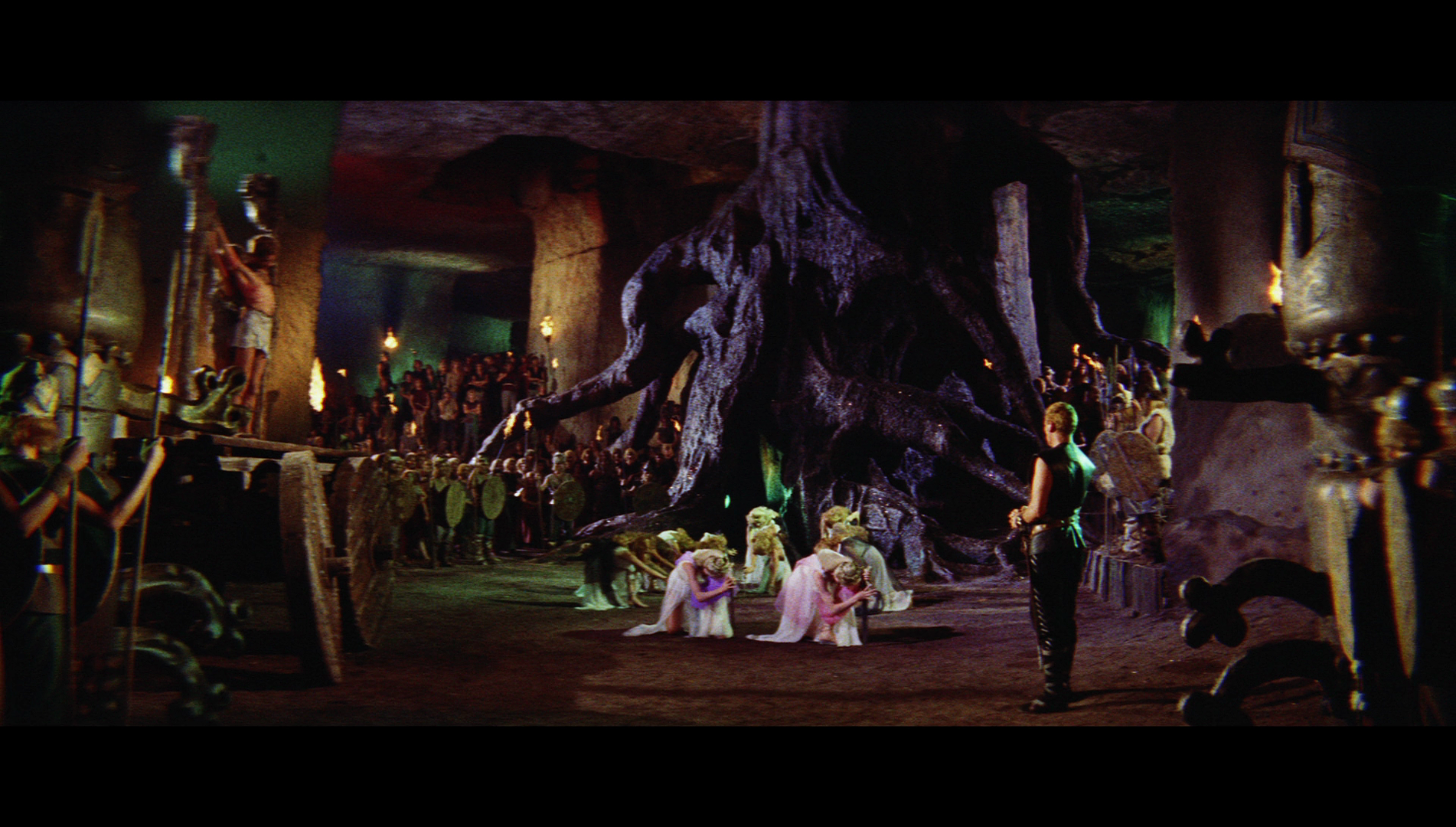
Though most of the film was shot in a studio environment, Bava fills the sets with vibrant colour, and the sets, costumes and décor are incredibly detailed (if not historically accurate: the narrative begins in 1786 but the costumes for the English characters seem to be from the 13th or 14th Centuries). In this presentation, colour is carried very well, the effects of the vibrant colour gels used on the lights being communicated excellently. The level of detail is superb, close-ups exhibiting a splendid amount of fine detail – one can count the beads of sweat on the brows of the actors. Contrast levels are very pleasing, rich and inky blacks being counterbalanced by strongly-defined midtones and balanced highlights. Damage is minimal, with the exception of a few vertical lines that are present here and there – notably in the opening massacre of the Viking settlement (see below). Finally, a strong encode ensures the presentation retains the structure of 35mm film. In all, it’s a tip-top, extremely pleasing presentation of the film. 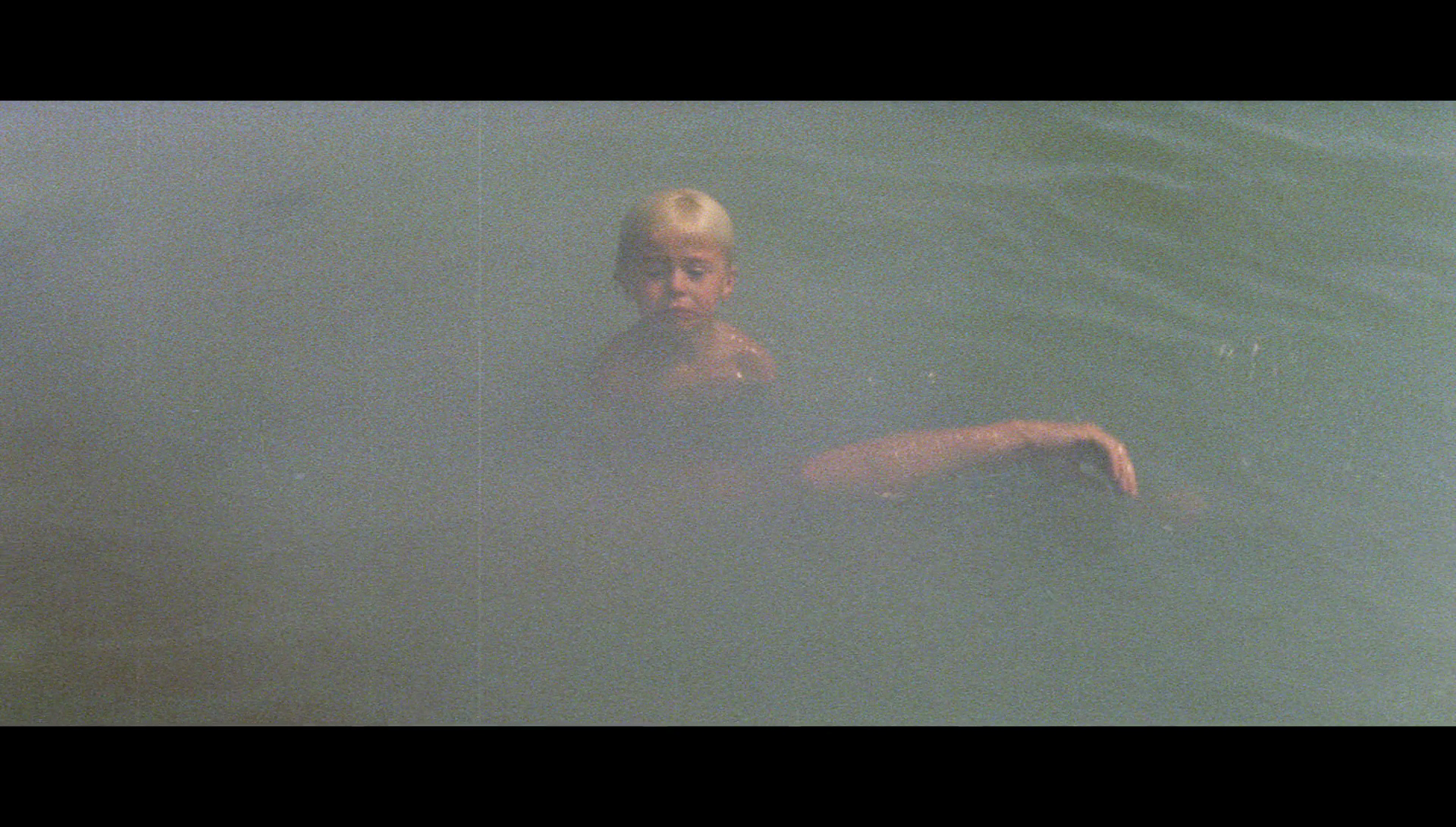
Audio
The disc presents the viewer with the option of watching the film in Italian or in English (both tracks are LPCM 1.0). The Italian track has optional English subtitles translating the Italian dialogue, and the English track has optional English subtitles for the Hard of Hearing. In terms of content, there isn’t a great deal of difference between the Italian and English dialogue. In terms of audio quality, the Italian track is crisp and clear with a strong sense of depth, whilst the English track is shrill and slightly ‘tinny’. Both sets of subtitles are easy to read and free from grammatical errors. Unfortunately, for whatever reason one cannot select between the two audio options ‘on the fly’: one has to dip into the menus to change from English to Italian or vice versa.
Extras
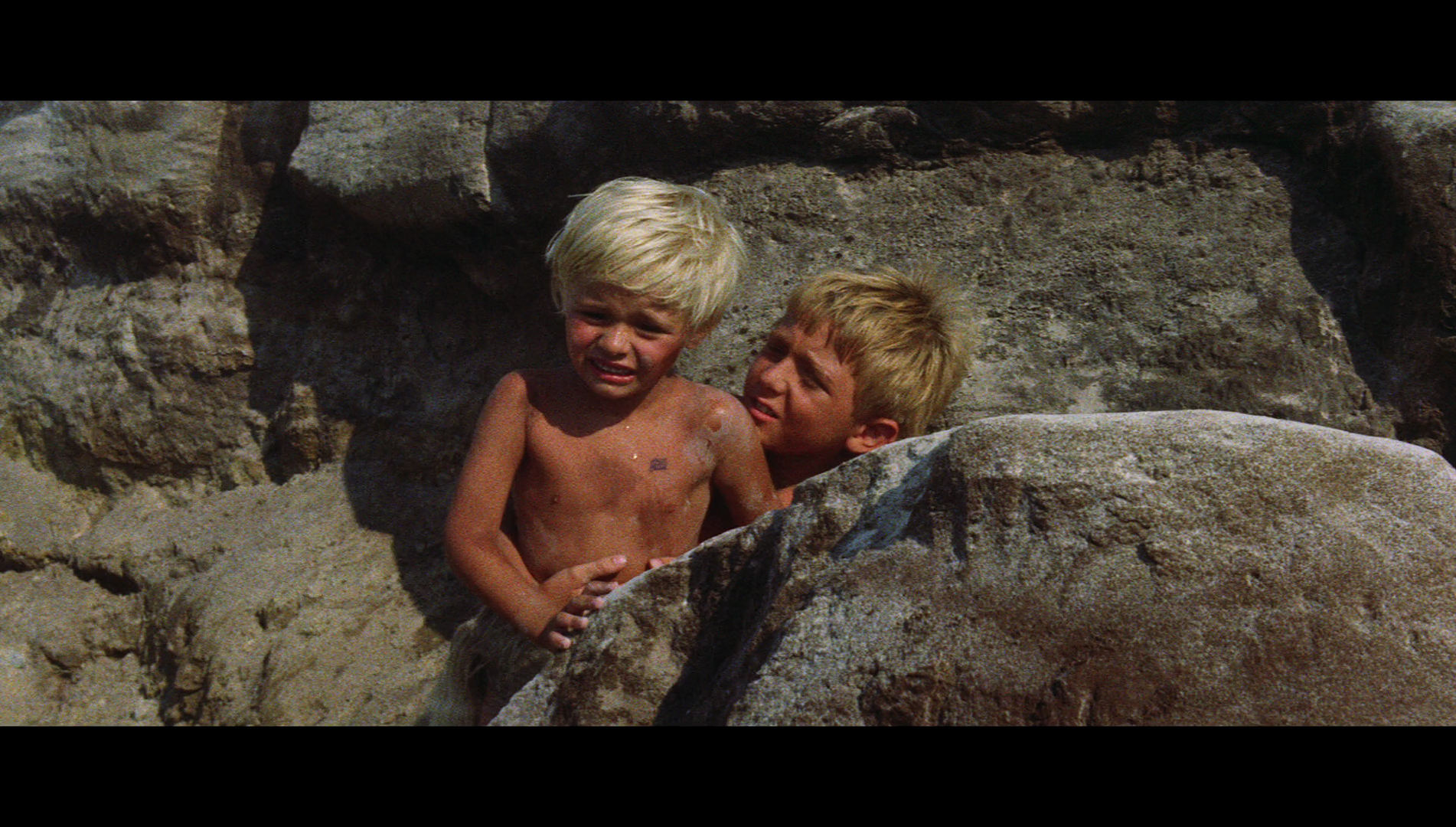 The disc includes: The disc includes:
- An audio commentary with Tim Lucas. Lucas delivers another breathless and superbly researched commentary which reflects on the film’s position in Bava’s filmography and its relationship with the Hollywood action films of the late 1950s and early 1960s. - ‘Gli imitatori’ (12:06). In this video essay, Michael Mackenzie explores the relationship between Fleischer’s The Vikings and Bava’s picture. Gli invasori wasn’t the only Italian film of this vintage to be influenced by the popularity of The Vikings, though there’s a definite sense of similarity between the narratives of both films that comes to some extent from their shared roots in the Norse myths about Ragnar Lodbrok. Mackenzie goes to the extreme of suggesting Gli invasori is an ‘uncredited remake’ of The Vikings, though that’s arguably like suggesting Robert Bresson’s Lancelot du lac (1974) is an ‘uncredited remake’ of Joshua Logan’s Camelot (1967) – in each case, the latter film was almost certainly made with the cognisance of its predecessor, and both have some basis in the same myths (the stories of Ragnar Lodbrok or King Arthur) and hit some of the same ‘beats’, but in each case the later picture was produced in very different cultural circumstances to its predecessor. Gli invasori takes The Vikings as its inspiration but looks aside to the stories of Ragnar Lodbrok and tells the story in a slightly different way – much like the multitude of films about Robin Hood, King Arthur or, to give two more immediately relevant examples for Bava’s picture, mythical figures such as Hercules and Maciste. Mackenzie’s discussion of the film is strong in terms of his examination of Bava’s motifs, but there’s a slightly defensive tone and focus on ‘imitation’ which I find a tad uncomfortable. Nevertheless, it’s an engaging featurette in which Mackenzie makes some lucid points about Bava’s signature style and filmmaking method. - The film’s original ending (1:24). This is simply an additional shot which is not present in the film’s original negative; it has been sourced from the UK VHS release and is of noticeably inferior quality to the main presentation, which onscreen text prefacing the footage asserts is the reason why it wasn’t integrated into the main feature on this disc. - An interview with Cameron Mitchell (63:23). This is an excellent audio interview with Cameron Mitchell, recorded in 1989. The interview was conducted by Tim Lucas, presumably via telephone. Mitchell is candid about his career and reflects on his experiences working for directors like Welles and Ford, and his friendships with Fellini and Bergman. The audio quality is a little ‘weak’ in places, but the content of the interview is superb.
Overall
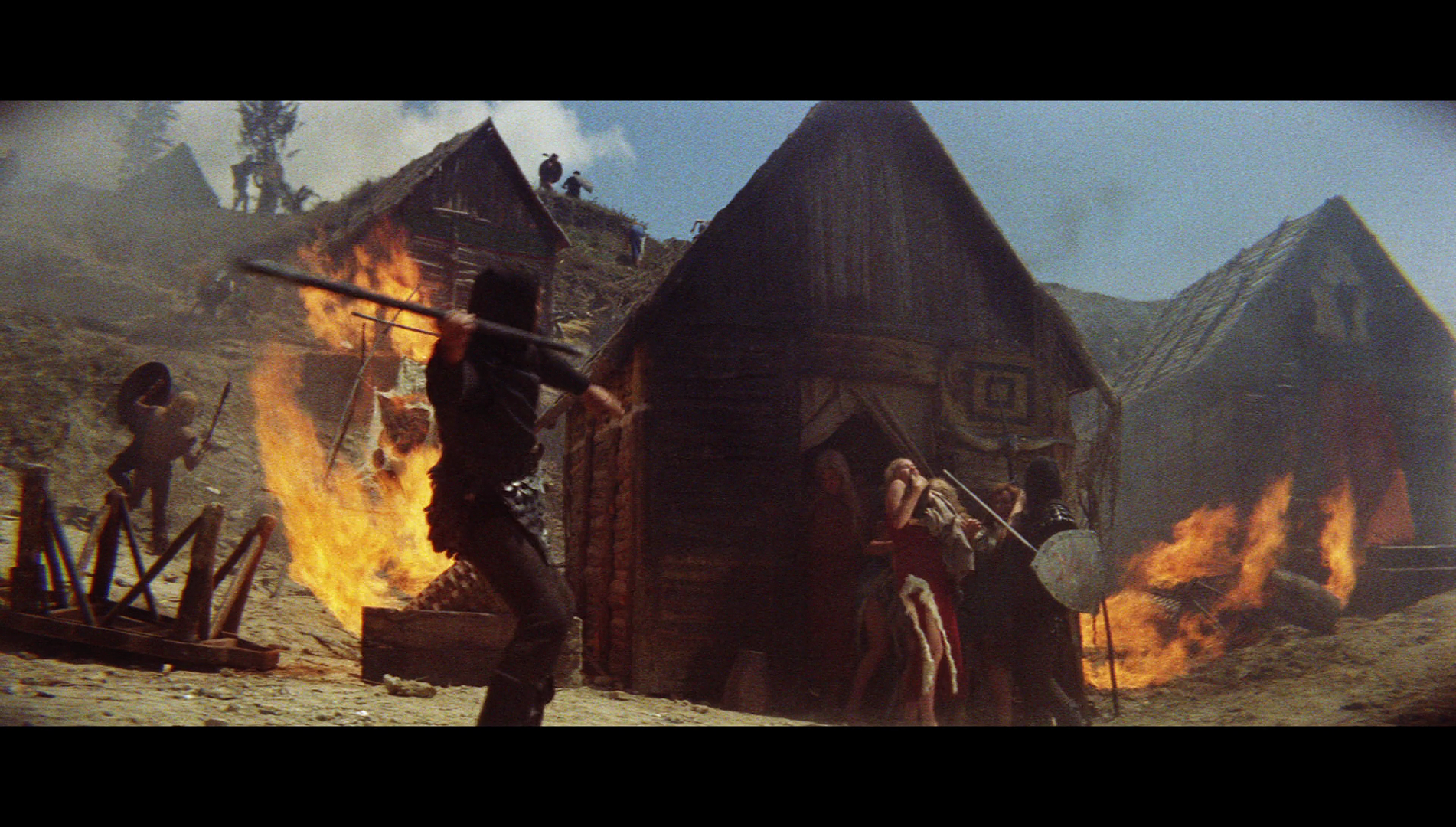 The film’s narrative may be a sizzling bag of clichés, but taken as a whole Gli invasori offers a feast for the eyes, featuring spectacular action and absolutely beautiful photography. Fans of pepla will find plenty to enjoy here, and the film has a strong sense of Bava’s visual style and eye for detail, offering a bridge between Bava’s monochrome early features and the vivid colour stylings of his 1960s horror pictures. Gli invasori also achieves a certain amount of novelty value in the casting of real-life twins Alice and Ellen Kessler as twin sisters Daya and Rama. There are some interesting similarities with John Milius’ later Conan the Barbarian, notably in the opening massacre of the Viking settlement and a climactic cremation of a main character, and one might wonder whether Milius had Bava’s film in mind when he made Conan. Regardless, Gli invasori is an entertaining film, and this Blu-ray release is very welcome indeed. The film’s narrative may be a sizzling bag of clichés, but taken as a whole Gli invasori offers a feast for the eyes, featuring spectacular action and absolutely beautiful photography. Fans of pepla will find plenty to enjoy here, and the film has a strong sense of Bava’s visual style and eye for detail, offering a bridge between Bava’s monochrome early features and the vivid colour stylings of his 1960s horror pictures. Gli invasori also achieves a certain amount of novelty value in the casting of real-life twins Alice and Ellen Kessler as twin sisters Daya and Rama. There are some interesting similarities with John Milius’ later Conan the Barbarian, notably in the opening massacre of the Viking settlement and a climactic cremation of a main character, and one might wonder whether Milius had Bava’s film in mind when he made Conan. Regardless, Gli invasori is an entertaining film, and this Blu-ray release is very welcome indeed.
Arrow’s new Blu-ray release contains an excellent presentation of the main feature. Some minor damage is present here and there (noticeably some vertical lines) and the lenses evidence the curious softening at the periphery of the frame that was a characteristic of many cheaper wide-angle lenses used wide-open, but the restoration as represented on this disc is very pleasing indeed. Alongside this deeply satisfying presentation, the disc includes some excellent contextual material: Lucas’ commentary and the interview with Mitchell are both excellent, and the video essay by Michael Mackenzie is, the slightly defensive approach towards its subject aside, filled with vivid comments about Bava’s signature approach to filmmaking. This is a superb presentation of an entertaining film, and Bava fans will undoubtedly want to add this disc to their collection. 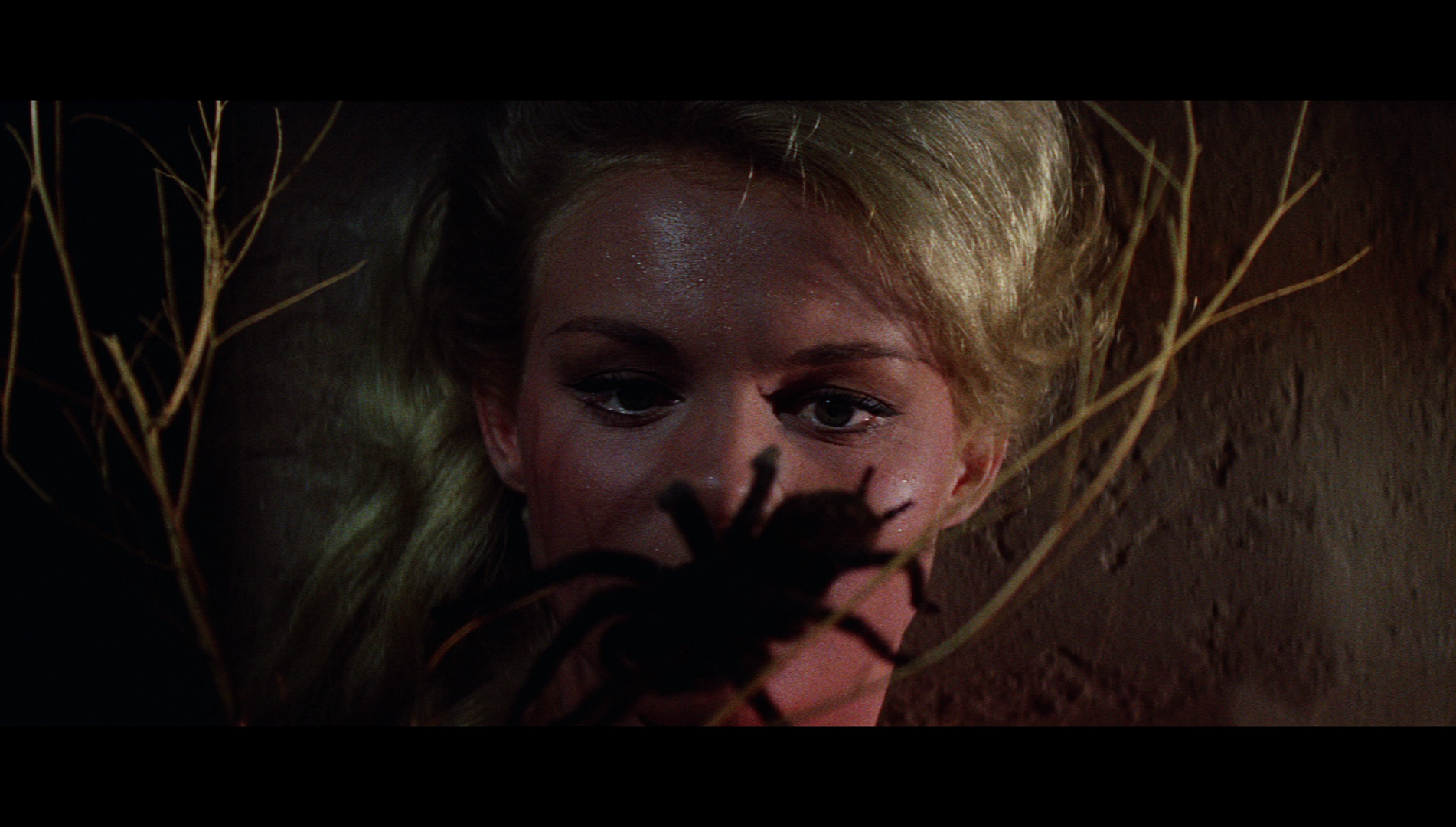
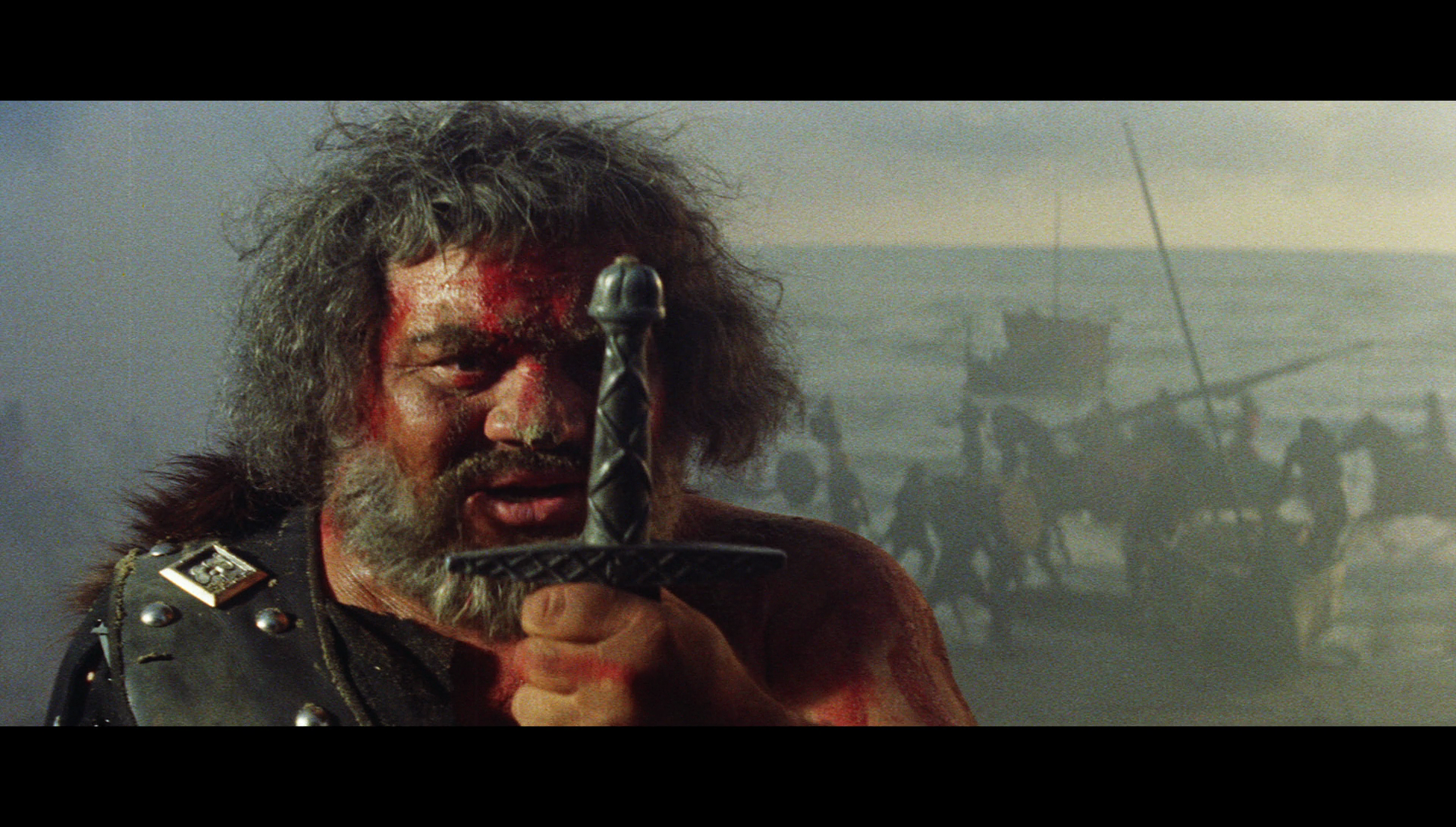
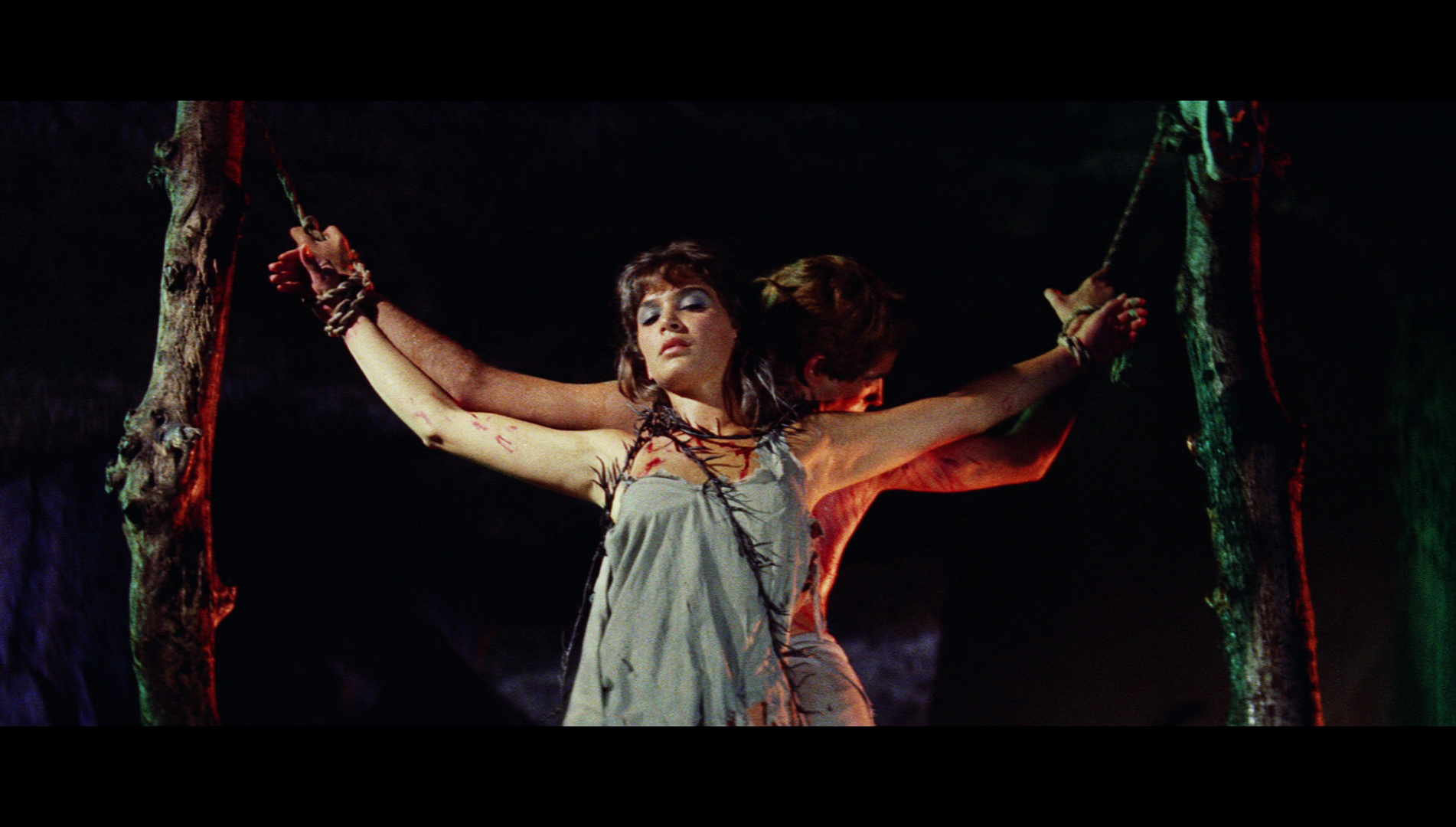
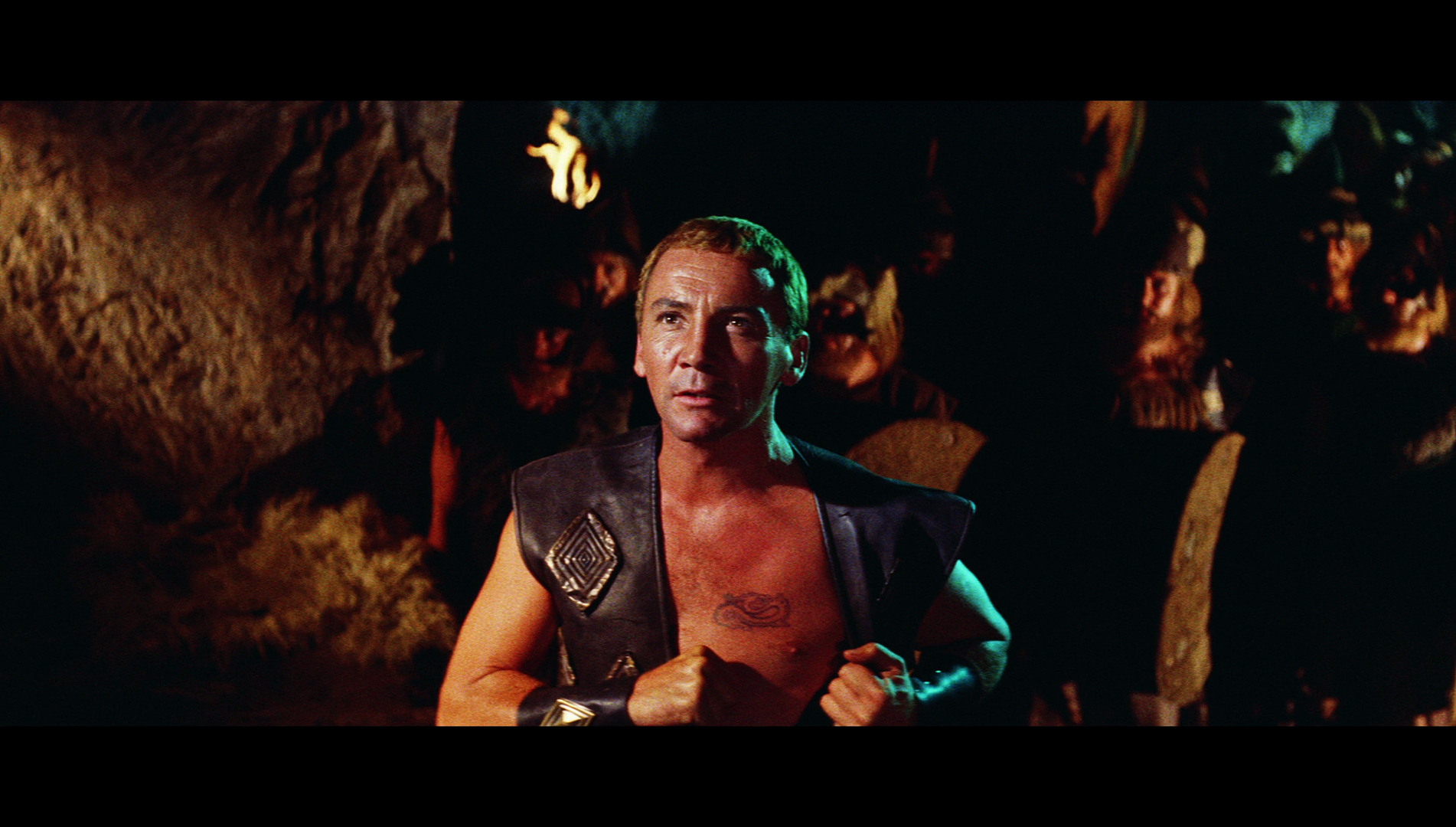
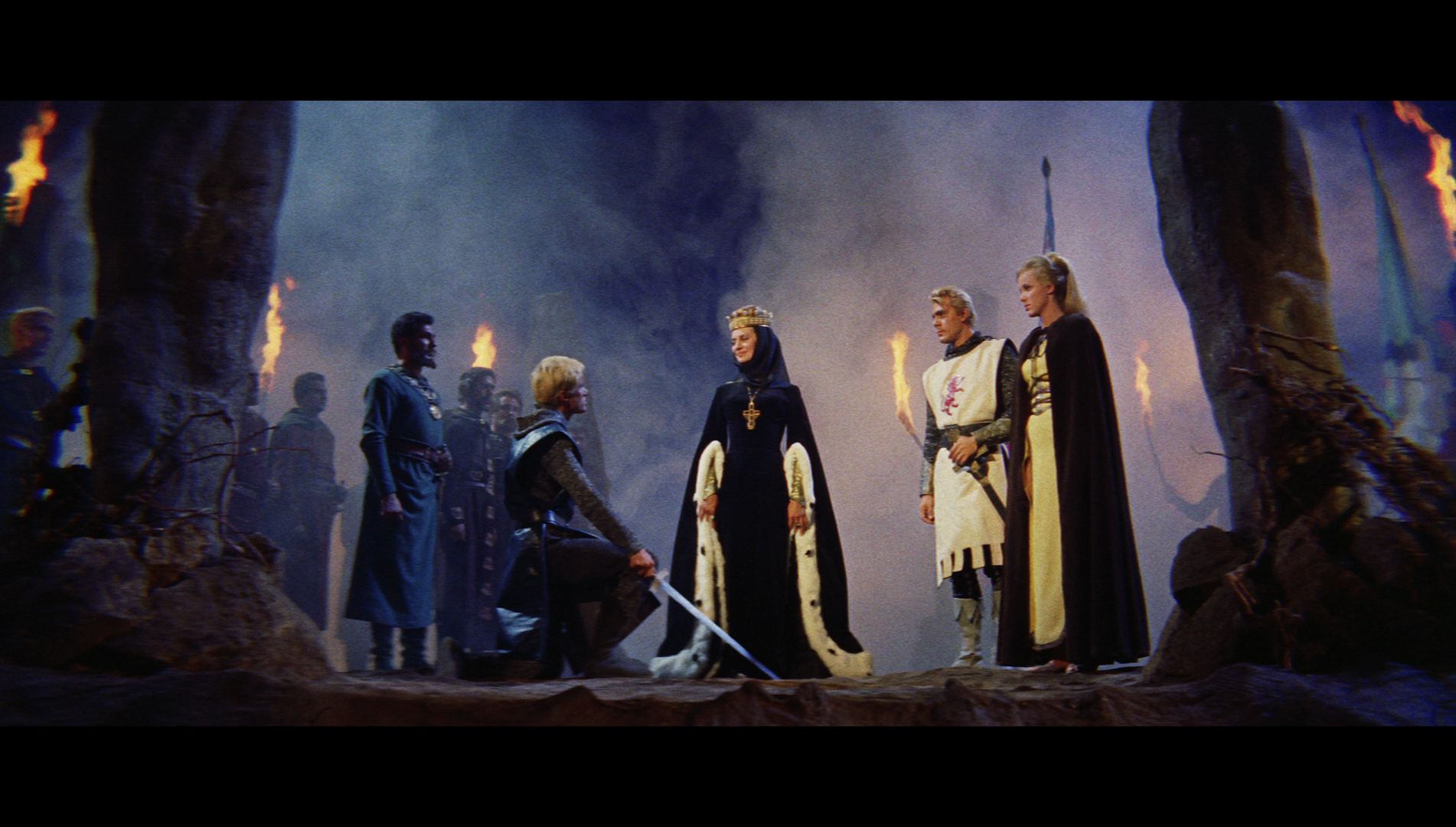
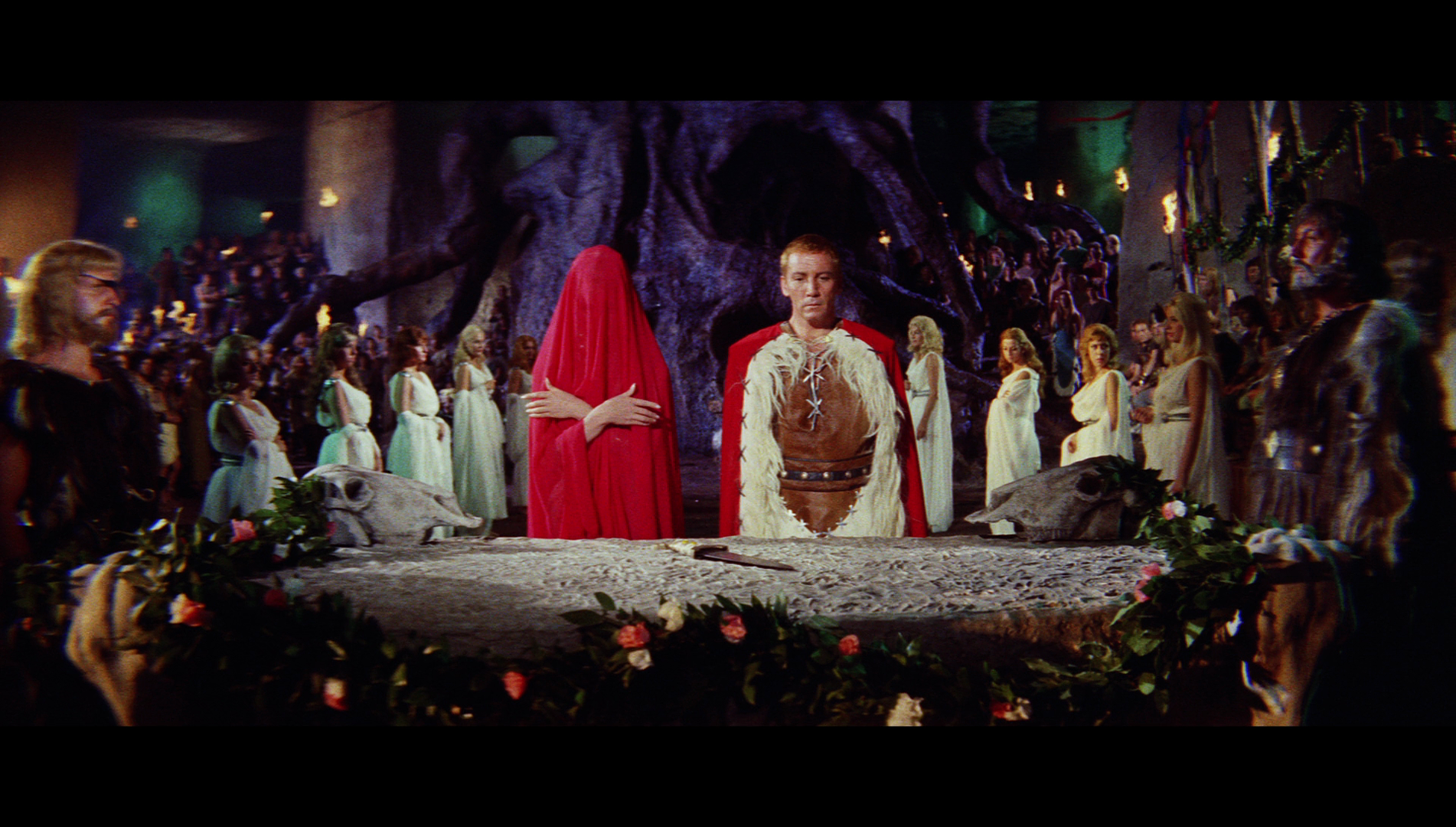
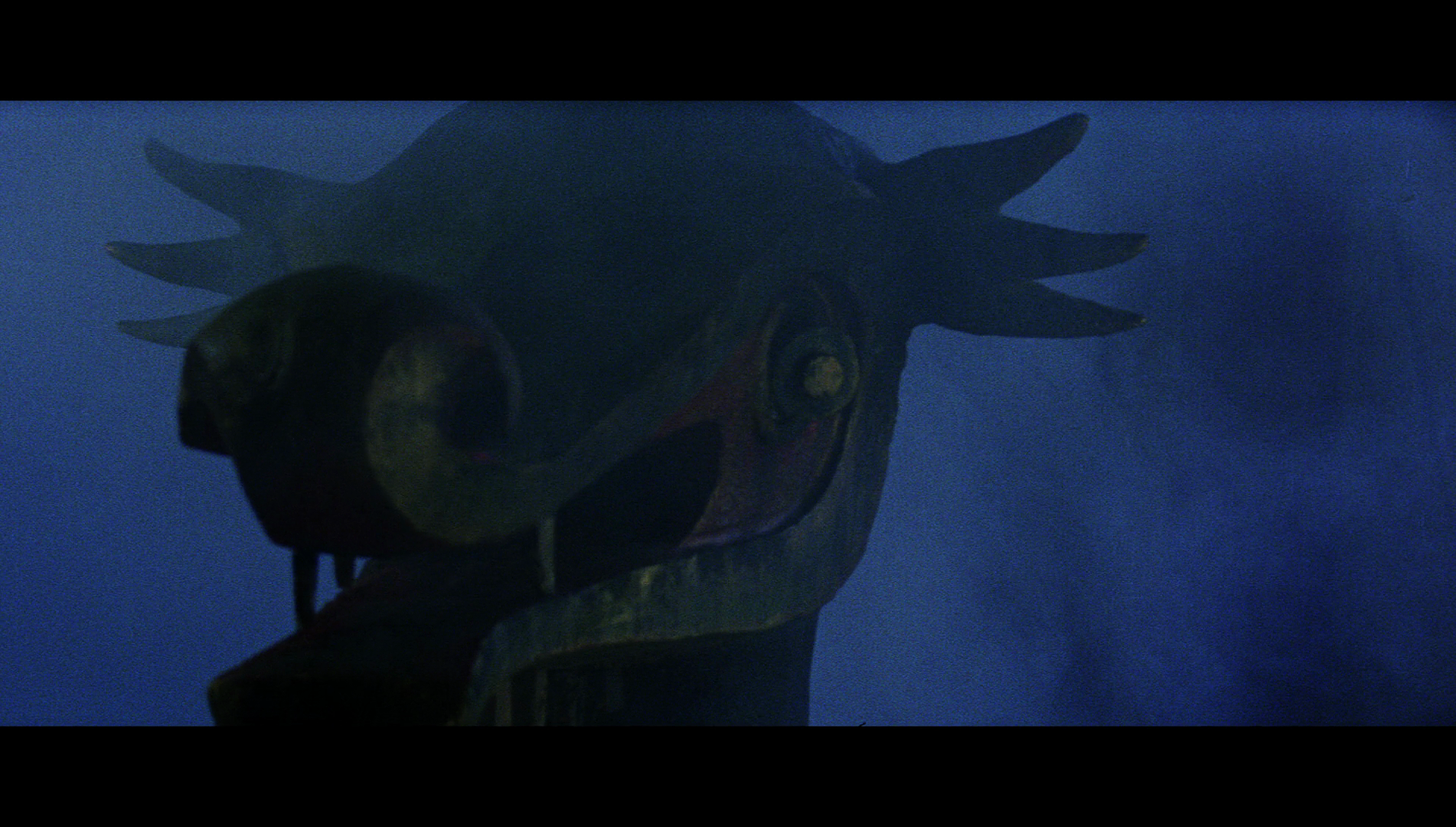
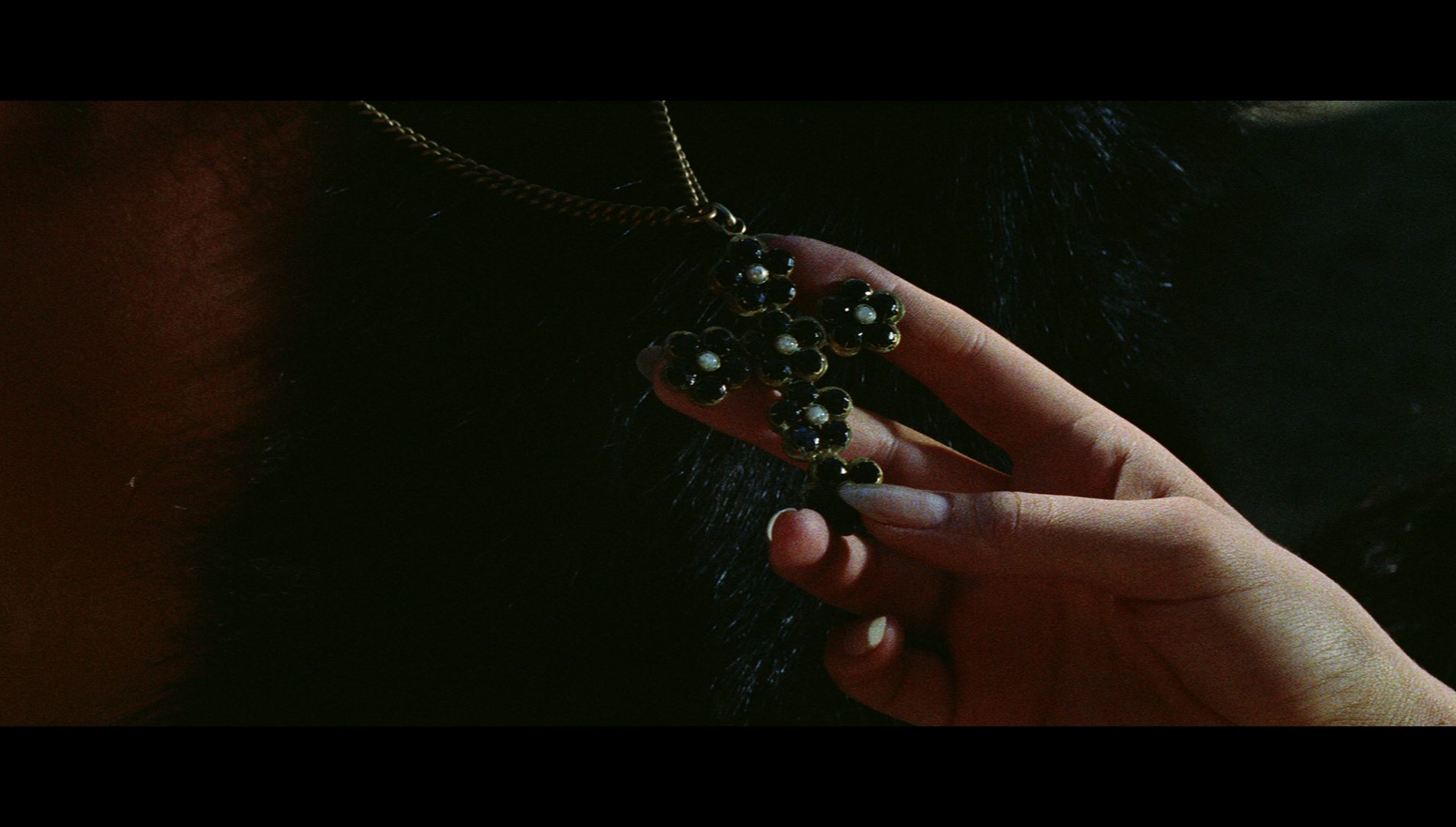
|
|||||

|